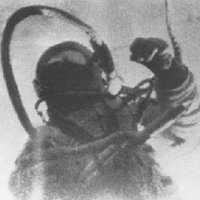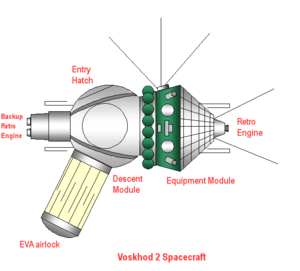Voskhod 2
|
|
| Mission Insignia | |
| Missing image Voskhod2patch.png image:voskhod2patch.png | |
| Mission Statistics | |
| Mission Name: | Voskhod 2 |
| Call Sign: | Алмаз (Almaz - "Diamond") |
| Number of Crew Members: | 2 |
| Launch: | March 18, 1965 07:00:00 UTC Baikonur LC1 |
| Begin Spacewalk: | March 18, 1965 08:34:51 UTC over north central Africa |
| End Spacewalk: | March 18, 1965 08:47:00 UTC over eastern Siberia |
| Landing: | March 19, 1965 09:02:17 UTC Template:Coor dm |
| Duration: | 1 day, 2 h, 2 min, 17 s |
| Number of Orbits: | 17 |
Voskhod 2 was a Soviet manned space mission. It set another space milestone as one of the cosmonauts on board became the first person to "walk in space".
| Contents |
Crew
- Pavel Belyayev - Commander
- Aleksei Leonov - Pilot
Backup Crew
- Yevgeni Zaikin - Commander
- Yevgeni Khrunov - Pilot
Mission Parameters
- Mass: 5682 kg
- Perigee: 167 km
- Apogee: 475 km
- Inclination: 64.8°
- Period: 90.9 min
The Voskhod spacecraft was fitted with a special inflatable airlock that was extended once it had reached orbit. Cosmonaut Aleksei Leonov donned a space suit and ventured outside the craft while the other member of the two-person crew, Pavel Belyayev remained inside. Leonov began his spacewalk 90 minutes into the mission at the end of the first orbit. The spacewalk lasted 20 minutes from 08:30 UTC to 08:50 UTC. It began over north central Africa (near northern Sudan/southern Egypt) and ended over eastern Siberia.
The Voskhod 2 spacecraft is basically a Vostok spacecraft that has had a backup, solid fuel retro rocket, added to the top of the descent module. The ejection seat was removed and two crew couches were added to the interior at a 90 degree angle to that of the Vostok crew position. An inflatable exterior airlock was also added to the descent module opposite the entry hatch. After use, the airlock was jettisoned. There was no provision for crew escape in the event of a launch or landing emergency. A solid fuel braking rocket was also added to the parachute lines to provide for a softer landing at touchdown. This was necessary because, unlike the Vostok, the crew lands with the Voskhod descent module.
Despite this spectacular feat, the mission was plagued with problems. After his ten minutes outside the Voskhod, Leonov found that his suit had stiffened to the point where he could not re-enter the airlock. Leonov worked around this by allowing some of his suit's pressure to bleed off, making it easier for him to bend the joints. After coming back inside, there were problems with sealing the hatch properly, and this was followed by a troublesome re-entry, when like some earlier Vostok spacecraft, the Voskhod's descent module did not separate cleanly. Finally, the crew landed in an inhospitable and heavily-wooded part of the Ural Mountains and spent a night surrounded by wolves while waiting for their recovery team.
General Kamanin's diary later gave the landing location of the Voskhod 2, "Saransk" (ball), as: "54 deg 12 min North, 45 deg 10 min East." Also according to General Kamanin's diary, a commander of one of the search helicopters reported finding Voskhod 2, "On the forest road between the villages of Sorokovaya and Shchuchino, about 30 kilometers southwest of the town of Berezniki, I see the red parachute and the two cosmonauts. there is deep snow all around....."
Voskhod 2 EVA Timeline
- 08:28:13 UTC - The Voskhod 2 airlock is depressurized by Leonov.
- 08:32:54 UTC - Leonov opens the Voskhod 2 airlock hatch.
- 08:34.51 UTC - EVA begins as Leonov leaves Voskhod 2 airlock.
- 08:47:00 UTC - EVA ends as Leonov reenters airlock. 12 minute EVA.
- 08:48:40 UTC - Voskhod 2 EVA hatch on the airlock is closed and secured by Leonov.
- 08:51:54 UTC - Leonov begins to repressurize the Voskhod 2 airlock.
Voskhod 2 EVA details
Immediately after reaching orbit in Voskhod 2, Leonov and Belyayev attached the EVA backpack to Leonov’s Berkut (“Golden Eagle”) suit. Berkut was a modified Vostok Sokol-1 intravehicular (IV) suit. A white metal backpack provided 45 min of oxygen for breathing and cooling. Oxygen vented through a relief valve into space, carrying away heat, moisture, and exhaled carbon dioxide. Suit pressure could be set at either 40.6 kilopascals (5.88 psi) or 27.4 kPa (3.97 psi).
Belyayev then deployed and pressurized the Volga inflatable airlock. The airlock was necessary because Vostok/Voskhod avionics were cooled by cabin air and would overheat if the capsule was depressurized for EVA. Volga was designed, built, and tested in just 9 months beginning in mid-1964. At launch Volga fitted over Voskhod 2’s hatch, extending 74 cm (30 in) beyond the spacecraft hull. The airlock comprised a metal ring 1.2 m (4.0 ft) wide fitted over Voskhod 2’s inward-opening hatch; a double-walled fabric airlock tube with a deployed length of 2.5 m (8.25 ft); and a metal upper ring 1.2 m (4.0 ft) wide around the inward-opening airlock hatch 65 cm (26 in) wide. Volga’s deployed internal volume was 2.5 m³ (88 ft³).
The fabric airlock tube was made rigid by about 40 airbooms clustered in three independent groups. Two groups were sufficient for deployment. The airbooms needed 7 min for full inflation. Four spherical tanks held sufficient oxygen to inflate the airbooms and pressurize the airlock. Two lights lit the airlock interior, and three 16-mm cameras - two inside the airlock and one outside on a boom mounted to the upper ring - were positioned to record the historic first spacewalk.
Belyayev controlled the airlock from inside Voskhod 2, but a set of backup controls for Leonov was suspended on bungee cords inside the airlock. Leonov entered Volga, then Belyayev sealed Voskhod 2 behind him and depressurized the airlock. Leonov opened Volga’s outer hatch and pushed out to the end of his 15.35 m (50.4 ft) umbilical. He later stated that the umbilical gave him tight control over his movements - an observation belied by subsequent U.S. EVA experience. Leonov reported looking down and seeing from the Straits of Gibraltar to the Caspian Sea.
After Leonov returned to his couch, Belyayev fired pyrotechnic bolts to discard Volga. Sergei Korolev, Chief Designer at OKB-1 Design Bureau (now RKK Energia), stated after the EVA that Leonov could have remained outside for much longer than he did, while Mstislav Keldysh, “chief theoretician” of the Soviet space program and President of the Soviet Academy of Sciences, said that the EVA showed that future cosmonauts would find work in space easy.
The government news agency TASS reported that, “outside the ship and after returning, Leonov feels well.” However, post-Cold War Russian documents have revealed a different story. They report that Leonov’s Berkut suit ballooned, making bending difficult. Because of this, Leonov was unable to reach the shutter switch on his thigh for his chest-mounted camera. He could not take pictures of Voskhod 2, nor was he able to recover the camera mounted on Volga which recorded his EVA for posterity. After 12 min Leonov reentered Volga.
Recent accounts say that he violated procedure by entering the airlock head first, then got stuck sideways when he turned to close the outer hatch. This forced him to flirt with dysbarism (the “bends”) by lowering his suit pressure so he could bend enough to free himself. Leonov recently revealed that he had a suicide pill he could have swallowed if he had been unable to ingress Voskhod 2 and Belyayev had been forced to leave him in orbit.
Doctors reported that Leonov nearly suffered heatstroke - his core body temperature climbed 1.8 °C (3.1 °F) in 20 min - and Leonov stated that he was “up to his knees” in sweat, so that his suit sloshed when he moved.
In an interview published in the Soviet Military Review in 1980, Leonov downplayed his difficulties and stated that “building manned orbital stations and exploring the Universe are inseparably linked with man’s activity in open space. There is no end of work in this field.”
See also
External links
- The Voskhod 2 mission revisited (http://www.svengrahn.pp.se/histind/Voskhod2/Voskhod2.htm)
- Walking to Olympus: An EVA Chronology - NASA Oct. 1997 (http://spaceflight.nasa.gov/spacenews/factsheets/pdfs/EVACron.pdf)
- REDIRECT Template:PD-USGov-NASAda:Voskhod 2


